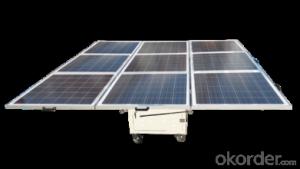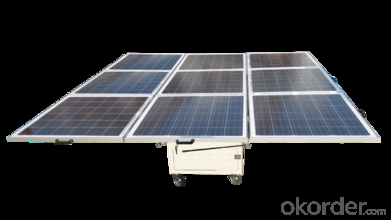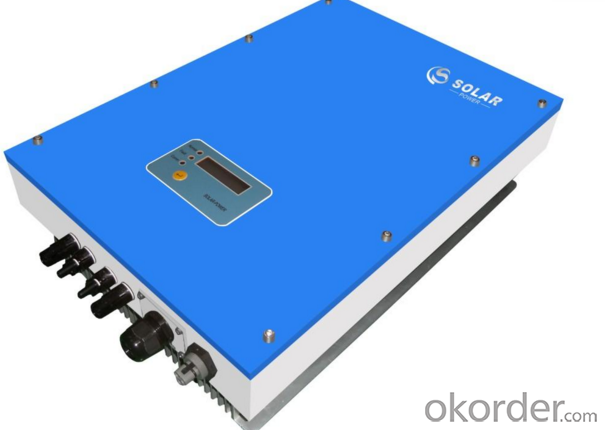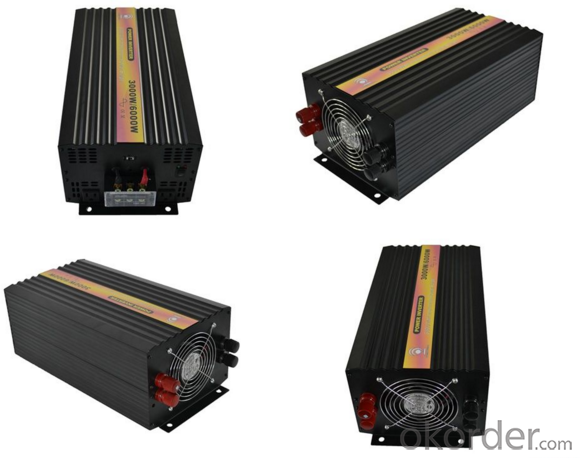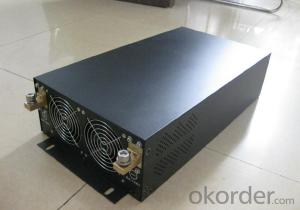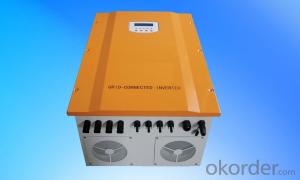MPPT Solar Inverter 48V - Single Phase Inverter Second Generation 3k Solar Inverter Made in China
- Loading Port:
- Shanghai
- Payment Terms:
- TT OR LC
- Min Order Qty:
- 0 watt
- Supply Capability:
- 10000 watt/month
OKorder Service Pledge
OKorder Financial Service
You Might Also Like
Description of Single Phase Inverter Second Generation 3k Solar Inverter
Solar ac power system consists of solar panels, charge controllers, inverter and battery; Solar energy does not include inverter dc power system. Inverter is a kind of power conversion device, inverter by incentives can be divided into self-excited oscillation inverter and separately excited oscillation inverter.
Features of Single Phase Inverter Second Generation 3k Solar Inverter
Standard 10 years warranty, 5-15 years optional
Built-in Gprs as option
Built-in Wifi as option
Smaller and lighter, only 9.6kg
High performance DSP for algorithm control
VDE-AR-N 4105 certification
New topology design
Dual MPPT design
Multi-button touch interface
LCD screen visible at night
Have anti-shading function
Advantages of Single Phase Inverter Second Generation 3k Solar Inverter
Longer life cycle
Plug and play
Free monitoring through our webportal
Very lower internal temperature
Easy transportation and installation
Faster CPU speed
Adjustable active and reactive power
Maximum conversion effciency up to 97.7%,Euro up to 96.9%
Real-time data readable at night
User friendly operation
Technical Data of Single Phase Inverter Second Generation 3k Solar Inverter
| Type | Omniksol-3k-TL2 |
| Input(DC) | |
| Max.PV Power | 3400W |
| Max,DC Voltage | 590V |
| Nominal DC Voltage | 360V |
| Operating MPPT Voltage Range | 120-550V |
| MPPT Voltage Range at Nominal Power | 150-500V |
| Start up DC Voltage | 150V |
| Turn off DC Voltage | 120V |
| Max, DC Current | 12A |
| Max, Short Cicuit Current for each MPPT | 16A |
| Number of MPP trackers | 2 |
| Max.Input Power for each MPPT | 2000W |
| Number of DC Connection for each MPPT | A:1/B:1 |
| DC Connection Type | MC4 connector |
| Output(AC) | |
| Max,AC Apparent Power | 3300VA |
| Nominal AC Power (cos phi = 1) | 3000W |
| Nominal Grid Voltage | 220V/230V/240V |
| Nominal Grid Frequency | 50Hz/60Hz |
| Max, AC Current | 14.4A |
| Grid Voltage Range** | 185-276V |
| Grid Frequency Range** | 45-55Hz/55-65Hz |
| Power Factor | 0.9 capacitive... 0.9 inductive |
| Total Harmonic Distortion(THD) | <2% |
| Feed in Starting Power | 30W |
| Night time Power Consumption | <1W |
| Standby Consumption | 6W |
| AC Connection Type | Plug-in connertor |
| Efficiency | |
| Max,Efficiency | 98.2% |
| Euro Efficiency | 97.3% |
| MPPT Efficiency | 99.9% |
| Safety and Protection | |
| DC Insulation Monitoring | Yes |
| DC Switch | Optional |
| Residual Current Monitoring Unit (RCMU) | Integrated |
| Grid Monitoring with Anti-islanding | Yes |
| Electricity Fuse Protection | Yes |
| Protection Class | Ⅰ(According to IEC 62103) |
| Overvoltage Category | PVⅡ/Mains Ⅲ(According to IEC 62109-1) |
| Reference Standard | |
| Safety Standard | EN 62109, AS/NZS 3100 |
| EMC Standard | EN 6100-6-1, EN 6100-6-2, EN 6100-6-3 EN 6100-6-4, EN 6100-3-2, EN 6100-3-3 |
| Grid Standard | VDE-AR-N4105. VDE-0126-1-1,G83/1,EN 50438,RD1699,CEI 0-21, AS4777,C10/C11 |
| Physical Structure | |
| Dimensions | 352x421x162.5mm |
| Weight | 16.5kg |
| Environmental Protection Rating | IP 65 (According to IEC 60529) |
| Cooling Concept | Internal fan convection |
| Mounting Information | Wall bracket |
| General Data | |
| Operating Temperature Range | -25℃ to +60℃(derating above 45℃) |
| Relative Humidity | 0% to 98%, no condensation |
| Max. Altitude (above sea level) | 2000m |
| Noise Type | <40dB |
| Isolation Type | Transformerless |
| Display | 3 LED ,Backlight, 4x20 Character LCD |
| Data Communication | RS485(WiFi, GRPS integrated) |
| Computer Communication | USB |
| Standard Warranty | 10 Years (5-15 years optional) |
IMages of Single Phase Inverter Second Generation 3k Solar Inverter
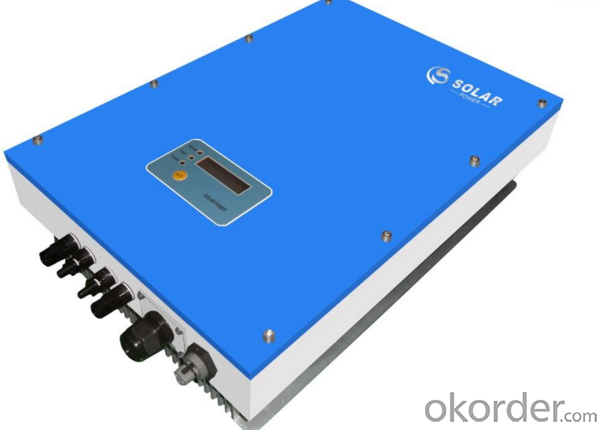
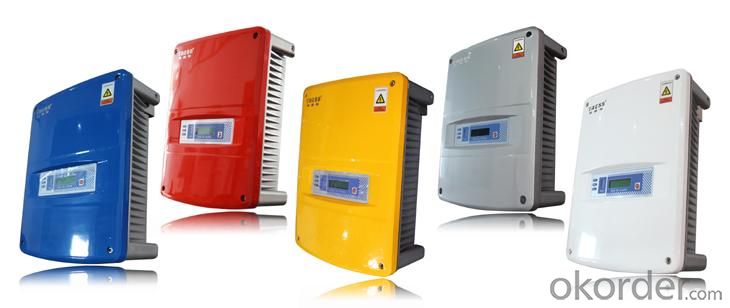
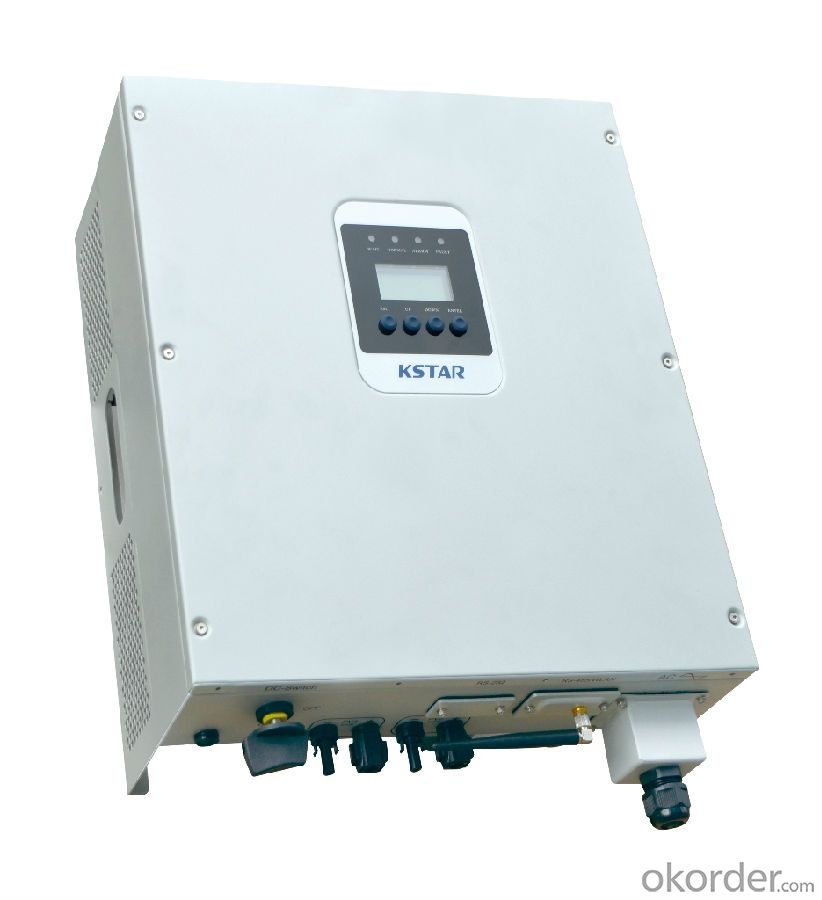
FAQ
Q: Do you have the CE, TUV, UL Certification?
A: We’ve already passed all the tests, and any certificate is available.
Q: Have you ever sold your products to companies in my country?
A: Of course, we have customers in all general PV markets, but I think we should expand our market share along with the market growth.
Q: When did your company set up? You are a new company, how can I believe your quality?
A: We entered into Solar PV industry in 2005, now we have several plants in manufacturing of a-Si and c-Si panels, and our capacity is 220MW per year. Till now we have already passed all the tests by authorized laboratories, e.g. TUV, CE, UL.
Q: Can you help us install the module if we cooperate with you?
A: We haven’t entered into installation sector, but we have the plan in near future.
Q: How do you pack your products?
A: We have rich experience on how to pack the panels to make sure the safety on shipment when it arrives at the destination.
Q: Can you do OEM for us?
A: Yes, we can.
Q: Can we visit your factory?
A: Surely, I will arrange the trip basing on your business schedule.
- Q: How does a solar inverter handle power surges or fluctuations?
- A solar inverter handles power surges or fluctuations by regulating the flow of electricity. It monitors the incoming power and adjusts the voltage and frequency to match the requirements of the connected devices. In case of power surges, the inverter has built-in protection mechanisms such as surge suppressors or voltage regulators to prevent any damage to the system. Additionally, some inverters feature advanced technologies like Maximum Power Point Tracking (MPPT) that optimize the solar panel's performance and enable better handling of fluctuations in power output.
- Q: Are there any government regulations or certifications for solar inverters?
- Yes, there are government regulations and certifications for solar inverters. In many countries, solar inverters must comply with specific standards and regulations set by government bodies. Additionally, various certifications such as International Electrotechnical Commission (IEC) standards, UL listing, and CE marking are commonly required to ensure the safety, performance, and interoperability of solar inverters.
- Q: What is the role of a power optimizer in a solar inverter?
- The role of a power optimizer in a solar inverter is to maximize the energy output of each individual solar panel by constantly monitoring and optimizing its performance. It ensures that each panel operates at its maximum power point, regardless of shading, dirt, or other factors that may affect the overall system performance. By individually optimizing each panel, a power optimizer can significantly increase the overall energy production of a solar system.
- Q: How does a solar inverter handle temperature variations?
- A solar inverter is designed to handle temperature variations by incorporating advanced thermal management systems. These systems ensure that the inverter operates within a specified temperature range, typically between -25 to 60 degrees Celsius. The inverter uses internal fans, heat sinks, and sometimes liquid cooling mechanisms to dissipate heat generated during operation. Additionally, the inverter may have temperature sensors that monitor the internal and external temperatures, allowing it to adjust its performance and efficiency accordingly. This temperature management enables the solar inverter to operate optimally and maintain its reliability even in extreme temperature conditions.
- Q: Three-phase photovoltaic inverter grid, the use of phase-locked loop is what?
- Grid-connected inverter can be operated locally through the LCD screen, or through remote monitoring with dedicated monitoring software.
- Q: Can a solar inverter be used in regions with high temperature extremes?
- Yes, solar inverters can be used in regions with high temperature extremes. However, it is important to consider the temperature range specified by the manufacturer for optimal performance and efficiency. Extreme heat may affect the inverter's efficiency and longevity, so proper cooling and ventilation should be ensured in such conditions.
- Q: What is the standby power consumption of a solar inverter?
- The standby power consumption of a solar inverter is typically very low, ranging from a few watts to a few tens of watts. This low power consumption ensures that minimal electricity is wasted when the inverter is not actively converting solar energy into usable electricity.
- Q: How does a solar inverter interact with a battery storage system?
- A solar inverter interacts with a battery storage system by converting the direct current (DC) electricity produced by solar panels into alternating current (AC) electricity, which is then used to charge the batteries. The inverter also ensures that the power from the batteries can be used to supply electricity to the loads when there is no sunlight or during a power outage. Additionally, the inverter manages the flow of electricity between the solar panels, battery, and the electrical grid, optimizing the system's overall efficiency.
- Q: How does a solar inverter handle voltage fluctuations?
- A solar inverter handles voltage fluctuations by continuously monitoring the input voltage from the solar panels. When there is a fluctuation in the input voltage, the inverter adjusts its internal circuitry to ensure a stable and consistent output voltage. This helps protect the connected appliances and grid from potential damage caused by sudden voltage changes.
- Q: What is the role of a solar inverter in anti-islanding protection?
- The role of a solar inverter in anti-islanding protection is to detect and prevent the occurrence of islanding. Islanding is a situation where a solar PV system continues to generate power and feed it into the grid during a power outage, which can pose a safety risk to utility workers attempting to restore power. The solar inverter monitors the grid voltage and frequency and when it detects an abnormality, such as a loss of grid connection, it quickly disconnects the PV system from the grid. This anti-islanding protection feature ensures that the solar system does not operate independently and helps maintain the safety and stability of the electrical grid.
Send your message to us
MPPT Solar Inverter 48V - Single Phase Inverter Second Generation 3k Solar Inverter Made in China
- Loading Port:
- Shanghai
- Payment Terms:
- TT OR LC
- Min Order Qty:
- 0 watt
- Supply Capability:
- 10000 watt/month
OKorder Service Pledge
OKorder Financial Service
Similar products
Hot products
Hot Searches
Related keywords
